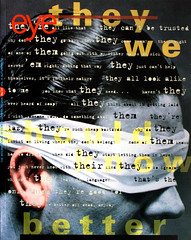Autumn 1994
Jekyll and Hyde
Letter from Nick Franchini in Eye 14

I agree with Malcolm Garrett that he can see both sides of an argument. His interview in Eye no. 12 vol. 3 is like an interview with two different people. I am writing to issue a note of caution because it appears that his avowedly blinkered approach to interactive design has created a Mr Hyde in him who threatens to eclipse Dr Jekyll.
In Garrett’s case, Dr Jekyll has a healthy respect for ‘the context, message and medium’, but Mr Hyde does not. Like others in the multimedia firmament, Mr Hyde is using technology as a Trojan horse to break into areas of the creative process he does not seem to understand – writing and editing. This is dangerous because like everything else, the development of interactive solutions must begin with the word – words facilitate the delivery and exchange of information, communicate expertise and understanding, and are the most effective means of presenting arguments and packaging detail. Without an intelligent use of words we cannot have concision, and interactive solutions need concision even more than primetime TV.
Mr Hyde skates over this in the interview because he wants graphic designers to take centre stage, but by doing so he is burying Dr Jekyll’s understanding of the nature of information. It is the inarticulate Mr Hyde who chooses the Oxford English Dictionary as a good example of interactive publishing and in the process betrays the poverty of his thinking. The OED is raw information which is not context-specific but self-contained.
In the wider world, information is interwoven with diverse processes and contexts. Reorganising or re-engineering these for interactive solutions requires a far wider set of skills. ‘Intuitive paths of retrieval’ do not just happen; they have to be created on the back of ‘decision trees’ with built-in expertise that enables everything to look and feel easy to use. The decision trees require experts in the subject matter and professional writers to create a dialogue-based process of information retrieval (and possibly exchange!) that grabs attention, holds interest and provokes desire and action.
Mr Hyde is right to highlight the relevance of television, but in his blindness he gets things the wrong way round. It is the interactive designers who need help. Interactive solutions would benefit from the familiarity that broadcast professionals have with a time-based medium, their editorial strength and their ability to wrap up information in a story or dialogue.
The lack of this expertise is all too obvious in most of the interactive information solutions pioneered by graphic designers. Too often they say the wrong thing to the wrong person in the wrong way at the wrong time. They leave users fazed and confused.
Like the early film-makers, graphic designers are too focused on space and composition to deal with an equally important variable – the dimension of time. They are no more suited to directing interactive solutions than they are to directing movies.
In interactive solutions the most important thing is to create a process and a dialogue. If that process and dialogue are then given as a brief to interactive designers who understand that ‘less is more’, you may get something that everyone will really want to use – interactive solutions where ‘computers become invisible’, like they are in the best of science fiction.
I bet Dr Jekyll would agree.
Nick Franchini, London
Eye is the world’s most beautiful and collectable graphic design journal, published quarterly for professional designers, students and anyone interested in critical, informed writing about graphic design and visual culture. It is available from all good design bookshops and online at the Eye shop, where you can buy subscriptions, back issues and single copies of the latest issue.

